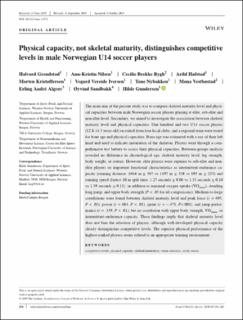Physical capacity, not skeletal maturity, distinguishes competitive levels in male Norwegian U14 players
Grendstad, Halvard Nikolai; Nilsen, Ann-Kristin; Rygh, Cecilie Brekke; Hafstad, Arild; Kristoffersen, Morten; Iversen, Vegard Vereide; Nybakken, Tone; Vestbøstad, Mona; Algrøy, Erling Andre; Sandbakk, Øyvind; Gundersen, Hilde
Peer reviewed, Journal article
Published version
Permanent lenke
https://hdl.handle.net/11250/2731996Utgivelsesdato
2019Metadata
Vis full innførselSamlinger
- Publikasjoner fra CRIStin [111]
- Tidsskriftartikler [94]
Originalversjon
Scandinavian Journal of Medicine & Science in Sports. 2019, 30 (2), 254-263. 10.1111/sms.13572Sammendrag
The main aim of the present study was to compare skeletal maturity level and physi-cal capacities between male Norwegian soccer players playing at elite, sub-elite and non-elite level. Secondary, we aimed to investigate the association between skeletal maturity level and physical capacities. One hundred and two U14 soccer players (12.8-14.5 years old) recruited from four local clubs, and a regional team were tested for bone age and physical capacities. Bone age was estimated with x-ray of their left hand and used to indicate maturation of the skeleton. Players went through a com-prehensive test battery to assess their physical capacities. Between-groups analysis revealed no difference in chronological age, skeletal maturity level, leg strength, body weight, or stature. However, elite players were superior to sub-elite and non-elite players on important functional characteristics as intermittent-endurance ca-pacity (running distance: 1664 m ± 367 vs 1197 m ± 338 vs 693 m ± 235) and running speed (fastest 10 m split time: 1.27 seconds ± 0.06 vs 1.33 seconds ± 0.10 vs 1.39 seconds ± 0.11), in addition to maximal oxygen uptake (̇VO2max), standing long jump, and upper body strength (P < .05 for all comparisons). Medium-to-large correlations were found between skeletal maturity level and peak force (r = 695, P < .01), power (r = 684, P < .01), sprint (r = −.471, P<.001), and jump perfor-mance (r = .359, P < .01), but no correlation with upper body strength, ̇VO2max, or intermittent-endurance capacity. These findings imply that skeletal maturity level does not bias the selection of players, although well-developed physical capacity clearly distinguishes competitive levels. The superior physical performance of the highest-ranked players seems related to an appropriate training environment.

